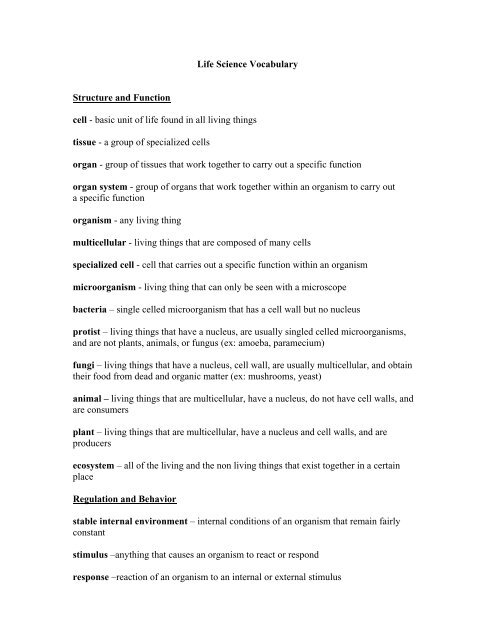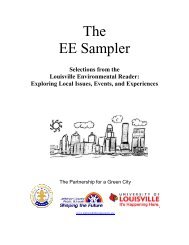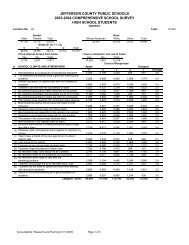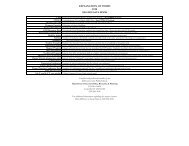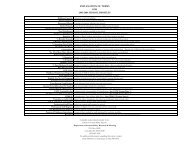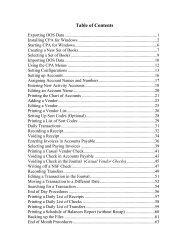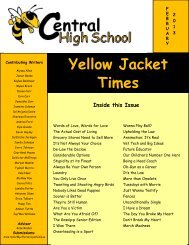Life Science Vocabulary Structure and Function cell - basic unit of ...
Life Science Vocabulary Structure and Function cell - basic unit of ...
Life Science Vocabulary Structure and Function cell - basic unit of ...
You also want an ePaper? Increase the reach of your titles
YUMPU automatically turns print PDFs into web optimized ePapers that Google loves.
<strong>Life</strong> <strong>Science</strong> <strong>Vocabulary</strong><br />
<strong>Structure</strong> <strong>and</strong> <strong>Function</strong><br />
<strong>cell</strong> - <strong>basic</strong> <strong>unit</strong> <strong>of</strong> life found in all living things<br />
tissue - a group <strong>of</strong> specialized <strong>cell</strong>s<br />
organ - group <strong>of</strong> tissues that work together to carry out a specific function<br />
organ system - group <strong>of</strong> organs that work together within an organism to carry out<br />
a specific function<br />
organism - any living thing<br />
multi<strong>cell</strong>ular - living things that are composed <strong>of</strong> many <strong>cell</strong>s<br />
specialized <strong>cell</strong> - <strong>cell</strong> that carries out a specific function within an organism<br />
microorganism - living thing that can only be seen with a microscope<br />
bacteria – single <strong>cell</strong>ed microorganism that has a <strong>cell</strong> wall but no nucleus<br />
protist – living things that have a nucleus, are usually singled <strong>cell</strong>ed microorganisms,<br />
<strong>and</strong> are not plants, animals, or fungus (ex: amoeba, paramecium)<br />
fungi – living things that have a nucleus, <strong>cell</strong> wall, are usually multi<strong>cell</strong>ular, <strong>and</strong> obtain<br />
their food from dead <strong>and</strong> organic matter (ex: mushrooms, yeast)<br />
animal – living things that are multi<strong>cell</strong>ular, have a nucleus, do not have <strong>cell</strong> walls, <strong>and</strong><br />
are consumers<br />
plant – living things that are multi<strong>cell</strong>ular, have a nucleus <strong>and</strong> <strong>cell</strong> walls, <strong>and</strong> are<br />
producers<br />
ecosystem – all <strong>of</strong> the living <strong>and</strong> the non living things that exist together in a certain<br />
place<br />
Regulation <strong>and</strong> Behavior<br />
stable internal environment – internal conditions <strong>of</strong> an organism that remain fairly<br />
constant<br />
stimulus –anything that causes an organism to react or respond<br />
response –reaction <strong>of</strong> an organism to an internal or external stimulus
Reproduction <strong>and</strong> Heredity<br />
reproduction – process by which organisms produce new organisms<br />
species – group <strong>of</strong> similar organisms that can mate <strong>and</strong> reproduce fertile <strong>of</strong>fspring<br />
asexual reproduction – process by which a single organism can reproduce by itself<br />
sexual reproduction – process by which sex <strong>cell</strong>s from two organisms join to reproduce<br />
a new organism<br />
egg – female reproductive <strong>cell</strong><br />
sperm – male reproductive <strong>cell</strong><br />
heredity – passing <strong>of</strong> characteristics or traits from one generation <strong>of</strong> organisms to<br />
another<br />
trait – specific characteristic that varies from one organism to another<br />
gene – small part <strong>of</strong> a chromosome that determines a specific trait for an organism<br />
chromosome – structure found in the nucleus that carries the genetic information for an<br />
organism<br />
Diversity <strong>and</strong> Adaptations <strong>of</strong> Organisms<br />
diversity – differences among traits within a species<br />
adaptation – inherited characteristic or trait that increases an organism’s chance <strong>of</strong><br />
survival<br />
extinction – disappearance <strong>of</strong> a species from its geographical range<br />
Populations <strong>and</strong> Ecosystems<br />
population – group <strong>of</strong> organisms <strong>of</strong> the same species that live in the same area<br />
producers – organisms that make their own food using the energy from the sun<br />
consumers – organism that gets its food supply from other organisms or plants<br />
decomposer – organism that breaks down <strong>and</strong> gets its food from dead organic matter<br />
food chain - the path <strong>of</strong> energy transfer (food) from one living thing to another in an<br />
ecosystem
food web – complex interactions formed by the feeding relationships among various<br />
organisms in an ecosystem<br />
photosynthesis – process that plants <strong>and</strong> some other organisms use to convert light<br />
energy into usable food energy<br />
abiotic factor – physical, or nonliving, thing that has an affect on the organisms in an<br />
ecosystem<br />
biotic factor – living components that affect other organisms in an ecosystem<br />
niche – all <strong>of</strong> the physical <strong>and</strong> biological conditions in which an organism lives <strong>and</strong> how<br />
it uses these conditions
<strong>Structure</strong> <strong>of</strong> the Earth System<br />
Earth <strong>and</strong> Space <strong>Science</strong> <strong>Vocabulary</strong><br />
earth materials - rocks, soils, water, <strong>and</strong> gases <strong>of</strong> the atmosphere<br />
soil - made <strong>of</strong> weathered rock, <strong>and</strong> decomposed organic material; properties are: color,<br />
texture, ability to retain water <strong>and</strong> support plant growth, <strong>and</strong> <strong>of</strong>ten layers <strong>of</strong> different<br />
chemical composition<br />
minerals - make up rocks; properties are color, texture, <strong>and</strong> hardness<br />
lithosphere – thin outer shell <strong>of</strong> the earth consisting <strong>of</strong> the crust <strong>and</strong> the rigid upper<br />
mantle<br />
crust – outermost layer <strong>of</strong> the earth<br />
mantle – layer <strong>of</strong> rock below the earth’s crust<br />
core – center <strong>of</strong> the earth below the mantle; consists mostly <strong>of</strong> iron <strong>and</strong> has a dense liquid<br />
layer <strong>and</strong> a dense solid center sphere<br />
lithospheric plates – separate pieces <strong>of</strong> the lithosphere that move very slowly due to<br />
motion in the mantle<br />
rock cycle – series <strong>of</strong> processes in which rock changes from one type to another <strong>and</strong> back<br />
again<br />
sedimentary rock – rock formed from hardened deposits <strong>of</strong> sediment<br />
metamorphic rock – rock formed from other rocks as result <strong>of</strong> intense heat, pressure, or<br />
chemical processes<br />
igneous rock – rock formed from cooled <strong>and</strong> hardened magma<br />
constructive force – forces that deform <strong>and</strong> change the surface <strong>of</strong> the earth (ex: crustal<br />
deformation, volcanic eruption, deposition <strong>of</strong> sediment)<br />
crustal deformation – the bending, tilting, <strong>and</strong> breaking <strong>of</strong> the earth’s crust caused<br />
mainly by movement <strong>of</strong> the lithospheric plates<br />
destructive force – forces that wear away <strong>and</strong> change the surface <strong>of</strong> the earth (ex:<br />
weathering, erosion)<br />
erosion – the slow movement <strong>of</strong> weathered rock <strong>and</strong> soil from one place to another<br />
caused by water, wind, gravity <strong>and</strong> glaciers
weathering - slow process that causes rocks to crumble, crack, <strong>and</strong> break, changing its<br />
physical form <strong>and</strong> chemical make up<br />
hydrosphere – all the earth’s water<br />
water cycle – continuous movement <strong>of</strong> water from the air to the earth <strong>and</strong> back again<br />
precipitation – process <strong>of</strong> water falling from clouds to earth in the form <strong>of</strong> rain, sleet,<br />
snow, or hail<br />
condensation – process <strong>of</strong> water vapor changing to liquid water<br />
evaporation – process <strong>of</strong> liquid water changing to water vapor<br />
atmosphere – thick blanket <strong>of</strong> gases (nitrogen, oxygen <strong>and</strong> trace gases) surrounding the<br />
earth<br />
troposphere – atmospheric layer closest to earth; nearly all weather change occurs here<br />
stratosphere – second atmospheric layer above the troposphere; nearly all <strong>of</strong> ozone<br />
found here<br />
mesosphere – third atmospheric layer above the stratosphere; coldest layer <strong>of</strong><br />
atmosphere<br />
thermosphere – highest layer <strong>of</strong> the earth’s atmosphere; very thin air<br />
weather – daily <strong>and</strong> seasonal changes in temperature, wind, <strong>and</strong> precipitation<br />
climate – general weather conditions over many years<br />
Earth’s History<br />
fossils – trace or remains <strong>of</strong> a plant or animal in sedimentary rock; preserved clues to<br />
what life on Earth <strong>and</strong> its environment were like long ago<br />
asteroid – fragment <strong>of</strong> rock that orbits the sun; impact with Earth can cause catastrophic<br />
influence on its history<br />
comet – body <strong>of</strong> rock, dust, ice, <strong>and</strong> gases that revolves around the sun in a long,<br />
elliptical orbit; impact with Earth can cause catastrophic influence on its history<br />
Earth in the Solar System<br />
solar system – the sun <strong>and</strong> the bodies (planets, moons, asteroids, comets) that revolve<br />
around it
orbit – elliptical path <strong>of</strong> motion that planets, asteroids, <strong>and</strong> comets make around the sun<br />
revolution – one complete movement (orbit) <strong>of</strong> a planet around the sun or a moon around<br />
a planet<br />
year – time required for the earth to make one revolution around the sun<br />
rotation – spinning <strong>of</strong> a planet on its axis<br />
day – time required for the earth to make one rotation on its axis<br />
phases <strong>of</strong> the moon - repeating monthly pattern <strong>of</strong> different moon shapes we see due to<br />
the moon’s movement around earth<br />
eclipse – passing <strong>of</strong> one planetary body through the shadow <strong>of</strong> another<br />
gravity – force <strong>of</strong> attraction between all matter in the universe; it is the force that keeps<br />
the planets in orbit <strong>and</strong> governs all motion in solar system<br />
tides – daily change in the level <strong>of</strong> the ocean surface caused by the gravitational pull <strong>of</strong><br />
the moon on the earth <strong>and</strong> its waters<br />
seasons – summer, fall, winter, spring caused by the tilt <strong>of</strong> the earth on its axis as it orbits<br />
the sun that changes the angle at which the sun’s rays strike the earth’s surface
Physical <strong>Science</strong> <strong>Vocabulary</strong><br />
Properties <strong>and</strong> Changes <strong>of</strong> Properties in Matter<br />
matter – all substance is made <strong>of</strong> this; it has mass <strong>and</strong> takes up space<br />
mass – the amount <strong>of</strong> matter in an object<br />
volume – amount <strong>of</strong> space occupied by an object or a substance<br />
physical property - characteristics that is observable or measurable in a substance<br />
without changing the chemical composition <strong>of</strong> the substance (ex: mass, density,<br />
temperature, boiling point, solubility)<br />
density – ratio <strong>of</strong> the mass <strong>of</strong> a substance to its volume, expressed in g/cm 3<br />
solubility – amount <strong>of</strong> a substance that will dissolve in a specific amount <strong>of</strong> another<br />
substance at a given temperature<br />
mixture – two or more substances that are blended without combining chemically<br />
physical change - change in shape, color or size, or state; a change without a change in<br />
chemical composition (ex: paper cut into pieces, water freezing, ice melting)<br />
chemical property – characteristics <strong>of</strong> a substance that determine how it reacts to form<br />
other substances (ex: combustion, corrosion)<br />
element – substance that cannot be broken down by physical or chemical means; consists<br />
<strong>of</strong> only one kind <strong>of</strong> atom<br />
periodic table – system that organizes the elements in a way that shows their common<br />
properties<br />
atom – smallest <strong>unit</strong> <strong>of</strong> an element that has the properties <strong>of</strong> that element<br />
compound – substance containing atoms <strong>of</strong> two or more elements that are chemically<br />
combined, always in the same ratio<br />
chemical change – change in which a substance becomes another substance with<br />
different properties (ex: wood burning, metal rusting)<br />
Motion <strong>and</strong> Forces<br />
motion - a change in the position <strong>of</strong> an object over time<br />
force - any push or pull (ex: gravity, friction)
elative position – location <strong>of</strong> an object as described in relation to a reference point (ex:<br />
you are st<strong>and</strong>ing to the left <strong>of</strong> the teacher’s desk)<br />
distance – the separation between two positions (ex: there are three feet between my desk<br />
<strong>and</strong> the door)<br />
speed – the rate <strong>of</strong> change <strong>of</strong> the position <strong>of</strong> an object; how fast something is moving (ex:<br />
55 miles per hour)<br />
constant speed – a speed that does not change<br />
unbalanced force – occurs when the forces acting on an object are not equal; therefore,<br />
one force is greater than the other which causes object’s speed or direction to change<br />
Transfer <strong>of</strong> Energy<br />
energy- property <strong>of</strong> many substances that give the ability to do work; many forms <strong>of</strong><br />
energy (i.e., light, heat, electricity, sound)<br />
energy transfer – changing energy from one form to another, such as potential to kinetic<br />
potential energy – energy that is being stored in an object<br />
kinetic energy – energy that a moving object has<br />
temperature – a measurement <strong>of</strong> the average kinetic energy in the particles <strong>of</strong> an object<br />
heat – energy that is transferred from an object at a high temperature to an object at a<br />
lower temperature<br />
reflection – bouncing <strong>of</strong> light <strong>of</strong>f <strong>of</strong> a surface<br />
refraction – bending <strong>of</strong> light as it passes from one substance into another<br />
electrical circuits - complete conducting path which allows electric current to flow<br />
through; electrical energy in circuit can be transferred into light, heat, sound<br />
conductor - material that allows electricity <strong>and</strong> heat to move through it (ex: metals)<br />
insulator – material that does not allow electricity <strong>and</strong> heat to flow through it (ex: wood,<br />
glass)


